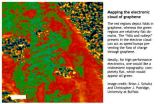Metal particle generates new hope for H2 energy
2011-06-28
(Press-News.org) Tiny metallic particles produced by University of Adelaide chemistry researchers are bringing new hope for the production of cheap, efficient and clean hydrogen energy.
Led by Associate Professor Greg Metha, Head of Chemistry, the researchers are exploring how the metal nanoparticles act as highly efficient catalysts in using solar radiation to split water into hydrogen and oxygen.
"Efficient and direct production of hydrogen from solar radiation provides a renewable energy source that is the pinnacle of clean energy," said Associate Professor Greg Metha. "We believe this work will contribute significantly to the global effort to convert solar energy into portable chemical energy."
The latest research is the outcome of 14 years of fundamental research by Associate Professor Metha's research group investigating the synthesis and properties of metal nanoparticles and how they work as catalysts at the molecular level.
The group works with metal "clusters" of about one-quarter of a nanometre in size – less than 10 atoms. Associate Professor Metha said these tiny "magic clusters" act as super-efficient catalysts. Catalysts drive chemical reactions, reducing the amount of energy required.
"We've discovered ways of producing these tiny metallic clusters, we've explored their fundamental chemical activity, and now we are applying their catalytic properties to reactions which have great potential benefit for industrial use and the environment," said Associate Professor Metha.
PhD student Jason Alvino is exploring splitting water to make hydrogen (and oxygen) using solar energy – a process that is not viable for industry development at the moment.
"We know this catalysis works very efficiently at the molecular level and now need to demonstrate it works on the macroscopic scale," said Associate Professor Metha.
"Splitting water to make hydrogen and oxygen requires a lot of energy and is an expensive process. We will be using solar radiation as the energy source, so there will be no carbon emissions and because the clusters work so efficiently as a catalyst, it will be a much better process.
"The ultimate aim is to produce hydrogen from water as a cheap portable energy source."
Associate Professor Metha said there were also other industrial chemical reactions that could be made feasible by these catalysts, using solar radiation as the energy source - with potentially significant environmental benefits. One example was converting carbon dioxide into methane or methanol with water.
INFORMATION: This project 'Solar Hydrogen: photocatalytic generation of hydrogen from water', has been funded under the three-year clean energy partnership between Adelaide Airport Ltd and the University's Centre for Energy Technology.
END
ELSE PRESS RELEASES FROM THIS DATE:
2011-06-28
OAK BROOK, Ill. – Researchers may have discovered one reason that African Americans are at increased risk for heart attacks and other cardiovascular events.
According to a new study published online in the journal Radiology, African Americans have increased levels of non-calcified plaque, which consists of buildups of soft deposits deep in the walls of the arteries that are not detected by some cardiac tests. Non-calcified plaque is more vulnerable to rupturing and causing a blood clot, which could lead to a heart attack or other cardiovascular event.
According to ...
2011-06-28
OAK BROOK, Ill. – Breast cancer screening with mammography results in a significant reduction in breast cancer mortality, according to long-term follow-up results of a large-scale Swedish trial. The results are published online in the journal Radiology.
"Mammographic screening confers a substantial relative and absolute reduction in breast cancer mortality risk in the long-term," said Stephen W. Duffy, M.Sc., professor of cancer screening at Queen Mary, University of London. "For every 1,000 to 1,500 mammograms, one breast cancer death is prevented."
The Swedish Two-County ...
2011-06-28
PHILADELPHIA — Patients treated with sunitinib and sorafenib responded to the flu vaccine, which suggests the agents do not damage the immune system as much as previously feared, according to a study in Clinical Cancer Research, a journal of the American Association for Cancer Research.
Keith Flaherty, M.D., director of developmental therapeutics at the Massachusetts General Hospital and a senior editor of Clinical Cancer Research, said the findings have broad implications beyond questions of patient management.
"The damage that chemotherapy does to normal, healthy ...
2011-06-28
This press release is available in French.LONDON (28 JUNE 2011)—A new analysis of progress in the global fight against malaria finds a four-fold increase in annual funding for malaria research and development (R&D) in just 16 years—increasing from US$121 million in 1993 to US$612 million in 2009, with a particularly rapid increase since 2004. The funding has generated the strongest pipeline of malaria control and prevention products in history.
The report warns, however, that even a small decline in annual funding could jeopardize this pipeline, derail development of ...
2011-06-28
Alameda Services, a Health Information Technology (HIT) consulting and training organization specializing in workforce development, has been recognized as a training affiliate for the CEHRS Exam, administered by the National Healthcare Association (NHA). As an affiliate, Alameda Services is able to prepare students for the rigorous national certification as part of its program. Students and healthcare providers often report a higher level of recruitment, retention and placement among those who obtain the electronic health record (EHR) certification. More information about ...
2011-06-28
Results from the longest running breast screening trial show that screening with mammography reduces the number of deaths from breast cancer.
The study*, by researchers at Queen Mary, University of London, shows that the number of deaths that are prevented goes up year after year.
The results are new evidence of the long-term benefits of regular breast screening.
Senior author, Professor Stephen Duffy explained: "Breast cancer can take many years to develop so to tell if screening is effective, we need to see how women fair in the long-term.
"In this study, we've ...
2011-06-28
Baltimore, Maryland, June 28, 2011 – Nurses, occupational and physical therapists, case managers and education staff, all working together at a 300-bed Nebraska rehabilitation hospital, have successfully implemented a team approach to dramatically reduce infections from urinary catheters, the most prevalent type of infection acquired in healthcare settings.
The interdisciplinary team at Madonna Rehabilitation Hospital in Lincoln, one of the largest free-standing rehabilitation hospitals in the country, reduced catheter associated urinary tract infections (CAUTIs) by 89 ...
2011-06-28
triCerat is excited to announce its debut at IT decisions in London, June 28-29 at the QEII Conference Centre in Westminster, London.
IT decisions addresses the current, significant developments affecting IT systems in the real world. The two-day program includes sessions on virtualization, storage, cloud computing, software-as-a-service (SaaS), mobile and wireless accessibility, security, green IT, and more. The 30-minute sessions and roundtable discussions were designed with time-efficiency in mind for the busy IT executive. Keynote speaker Tim Jennings, Research Fellow ...
2011-06-28
Baltimore, Maryland, June 28, 2011 – Nurses on a surgical intensive care unit (SICU) at a large academic medical center cut bloodstream infections to zero and saved more than $200,000 during a six-month period.
The University of Maryland Medical Center SICU sustained a rate of zero central line-associated bloodstream infections (CLABSIs) for a 25-week period, eliminating 14 CLABSIs and saving 2-3 lives when compared to the same time period in the previous year, according to results of an intensive, six-month nursing initiative presented today at the 38th Annual Educational ...
2011-06-28
BUFFALO, N.Y. -- A research team led by University at Buffalo chemists has used synchrotron light sources to observe the electron clouds on the surface of graphene, producing a series of images that reveal how folds and ripples in the remarkable material can harm its conductivity.
The research, scheduled to appear June 28 in Nature Communications, was conducted by UB, the National Institute of Standards and Technology (NIST), the Molecular Foundry at Lawrence Berkeley National Laboratory (Berkeley Lab), and SEMATECH, a global consortium of semiconductor manufacturers.
Graphene, ...
LAST 30 PRESS RELEASES:
[Press-News.org] Metal particle generates new hope for H2 energy

